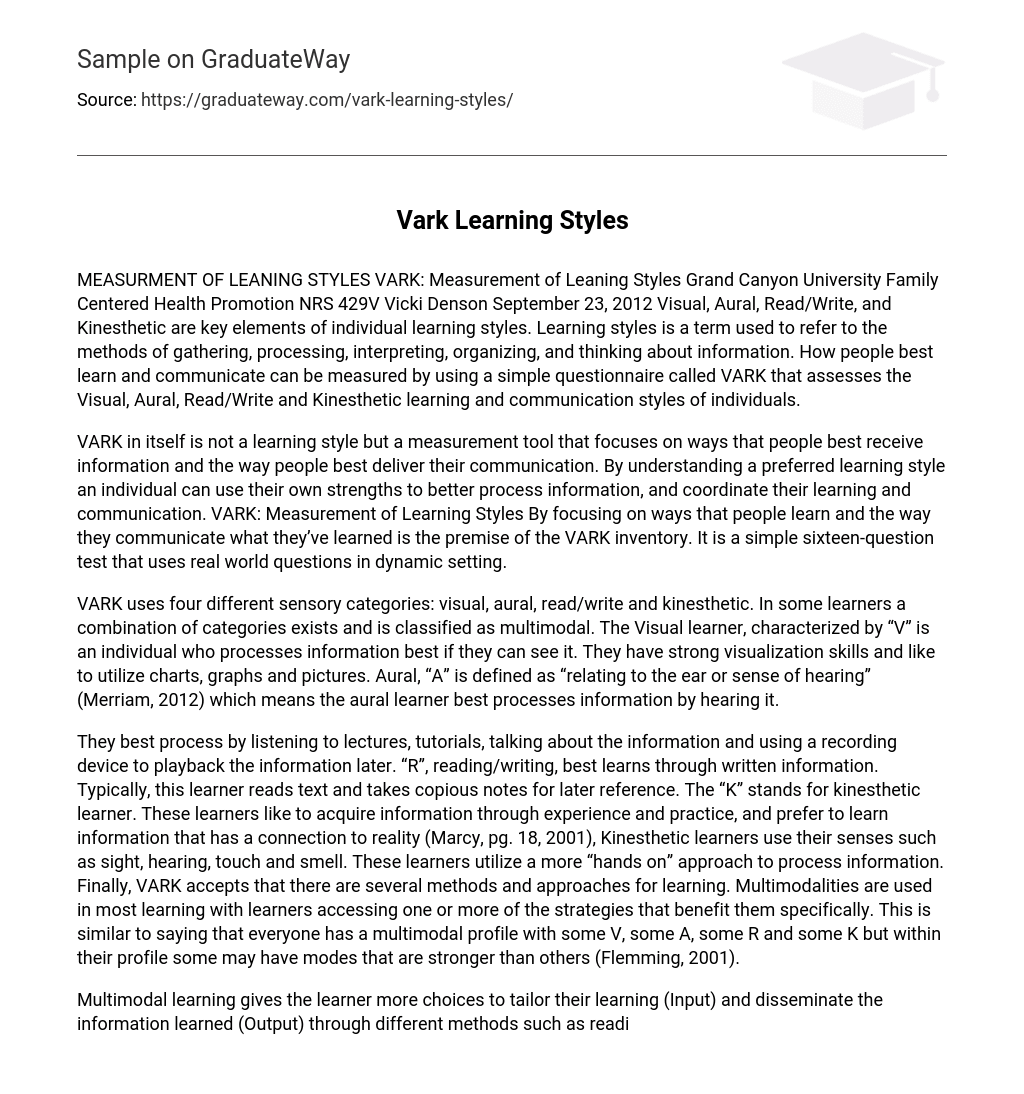Measurement of Leaning Styles Grand Canyon University Family Centered Health Promotion NRS 429V Vicki Denson September 23, 2012 Visual, Aural, Read/Write, and Kinesthetic are key elements of individual learning styles. Learning styles is a term used to refer to the methods of gathering, processing, interpreting, organizing, and thinking about information. How people best learn and communicate can be measured by using a simple questionnaire called VARK that assesses the Visual, Aural, Read/Write and Kinesthetic learning and communication styles of individuals.
VARK in itself is not a learning style but a measurement tool that focuses on ways that people best receive information and the way people best deliver their communication. By understanding a preferred learning style an individual can use their own strengths to better process information, and coordinate their learning and communication. VARK: Measurement of Learning Styles By focusing on ways that people learn and the way they communicate what they’ve learned is the premise of the VARK inventory. It is a simple sixteen-question test that uses real world questions in dynamic setting.
VARK uses four different sensory categories: visual, aural, read/write and kinesthetic. In some learners a combination of categories exists and is classified as multimodal. The Visual learner, characterized by “V” is an individual who processes information best if they can see it. They have strong visualization skills and like to utilize charts, graphs and pictures. Aural, “A” is defined as “relating to the ear or sense of hearing” (Merriam, 2012) which means the aural learner best processes information by hearing it.
They best process by listening to lectures, tutorials, talking about the information and using a recording device to playback the information later. “R”, reading/writing, best learns through written information. Typically, this learner reads text and takes copious notes for later reference. The “K” stands for kinesthetic learner. These learners like to acquire information through experience and practice, and prefer to learn information that has a connection to reality, Kinesthetic learners use their senses such as sight, hearing, touch and smell. These learners utilize a more “hands on” approach to process information. Finally, VARK accepts that there are several methods and approaches for learning. Multimodalities are used in most learning with learners accessing one or more of the strategies that benefit them specifically. This is similar to saying that everyone has a multimodal profile with some V, some A, some R and some K but within their profile some may have modes that are stronger than others (Flemming, 2001).
Multimodal learning gives the learner more choices to tailor their learning (Input) and disseminate the information learned (Output) through different methods such as reading and kinesthetic, aural and reading or a combination of all three. Members of Grand Canyon University RN-BSN NRS-429V completed the VARK questionnaire to determine the best method or methods to garner or disseminate information. The results of the questionnaire revealed that the multimodal method Aural, Reading/Writing, and Kinesthetic (ARK) was the preferred method of learning and communicating for this writer.
Multimodal learning preferences provide this learner with greater ability to adapt to the information learned and to communicate the information to others. The learning strategies most used by this writer when studying are the repetitive memorization gained by re-reading material and listening to the instructor and others discussing the topic. The discussion stimulates the process of both memorized material and new concepts. Writing lectures down verbatim helps to structure the learning and categorize the subject material for this writer.
Finally, for kinesthetic learning hands on demonstration and return demonstrations, approach to learning is the preferred method of learning for this participant when learning complex physical tasks. The VARK questionnaire demonstrated several key learning styles for this participant with high scores noted on Aural, Reading/Writing and Kinesthetic learning. As noted in the previous paragraph the writer’s preferred method of learning is primarily in two areas reading/writing and kinesthetic. The high aural scores do not appear accurate in this participants learning method as noted in the preferred modes of learning.
Writing notes verbatim during in class lectures may count towards the high aural scores, as this requires a high level of listening skills to process aural learning to written learning. VARK provides a study guide after the questionnaire is completed. Review of the guide shows that currently this participant uses most of the strategies for learning in the Aural, Reading/Writing and Kinesthetic modes. This participant has never used a recording devices but this may be an interesting method to use to reinforce aural/written learning as the taking of notes verbatim can be challenging in a class setting.
As a guide to learning styles, VARK provides the participants with written examples of their preferred learning styles. As stated by VARK the preferred method of learning for participants in multimodal as approximately 60% of any population fits that category (VARK, 2011). Although not completely accurate, the VARK questionnaire provides this participant with information that reinforces the preferred learning methods and is useful in giving examples for the multimodal learner.





